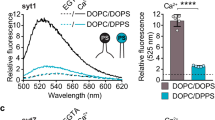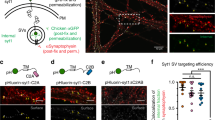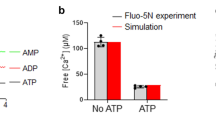Abstract
Ca2+-triggered dense-core vesicle exocytosis in PC12 cells does not require vesicular synaptotagmins 1 and 2, but may use plasma membrane synaptotagmins 3 and 7 as Ca2+ sensors. In support of this hypothesis, C2 domains from the plasma membrane but not vesicular synaptotagmins inhibit PC12 cell exocytosis. Ca2+ induces binding of both plasma membrane and vesicular synaptotagmins to phospholipids and SNAREs (soluble N-ethylmaleimide-sensitive attachment protein receptors), although with distinct apparent Ca2+ affinities. Here we used gain-of-function C2-domain mutants of synaptotagmin 1 and loss-of-function C2-domain mutants of synaptotagmin 7 to examine how synaptotagmins function in dense-core vesicle exocytosis. Our data indicate that phospholipid- but not SNARE-binding by plasma membrane synaptotagmins is the primary determinant of Ca2+-triggered dense-core vesicle exocytosis. These results support a general lipid-based mechanism of action of synaptotagmins in exocytosis, with the specificity of various synaptotagmins for different types of fusion governed by their differential localizations and Ca2+ affinities.
This is a preview of subscription content, access via your institution
Access options
Subscribe to this journal
Receive 12 print issues and online access
$209.00 per year
only $17.42 per issue
Buy this article
- Purchase on Springer Link
- Instant access to full article PDF
Prices may be subject to local taxes which are calculated during checkout








Similar content being viewed by others
References
Matthew, W.D., Tsavaler, L. & Reichardt, L.F. Identification of a synaptic vesicle-specific membrane protein with a wide distribution in neuronal and neurosecretory tissue. J. Cell Biol. 91, 257–269 (1981).
Perin, M.S., Brose, N., Jahn, R. & Südhof, T.C. Domain structure of synaptotagmin (p65). J. Biol. Chem. 266, 623–629 (1991).
Geppert, M., Archer, B.T. III & Südhof, T.C. Synaptotagmin II: a novel differentially distributed form of synaptotagmin. J. Biol. Chem. 266, 13548–13552 (1991).
Geppert, M., Goda, Y., Hammer, R.E., Li, C., Rosahl, T.W., Stevens, C.F. & Südhof, T.C. Synaptotagmin I: a major Ca2+ sensor for transmitter release at a central synapse. Cell 79, 717–727 (1994).
Fernández-Chacón, R. et al. Synaptotagmin I functions as a Ca2+-regulator of release probability. Nature 410, 41–49 (2001).
Voets, T. et al. Intracellular calcium dependence of large dense-core vesicle exocytosis in the absence of synaptotagmin 1. Proc. Natl. Acad. Sci. USA 98, 11680–11685 (2001).
Davletov, B. & Südhof, T.C. A single C2-domain from synaptotagmin I is sufficient for high affinity Ca2+/phospholipid-binding. J. Biol. Chem. 268, 26386–26390 (1993).
Chapman, E.R. & Jahn, R. Calcium-dependent interaction of the cytoplasmic region of synaptotagmin with membranes. Autonomous function of a single C2-homologous domain. J. Biol. Chem. 269, 5735–5741 (1994).
Li, C. et al. Ca2+-dependent and Ca2+-independent activities of neural and nonneural synaptotagmins. Nature 375 594–599 (1995).
Fernandez, I. et al. Three-dimensional structure of the synaptotagmin 1 C2B-domain: synaptotagmin 1 as a phospholipid-binding machine. Neuron 32, 1057–1069 (2001).
Sugita, S., Shin, O-H., Han, W., Lao, Y. & Südhof, T.C. Synaptotagmins form a hierarchy of exocytotic Ca2+-sensors with distinct Ca2+-affinities. EMBO J. 21, 270–280 (2002).
Südhof, T.C. Synaptotagmins: why so many? J. Biol. Chem. 277, 7629–7632 (2002).
Bennett, M.K., Calakos, N. & Scheller, R.H. Syntaxin: a synaptic protein implicated in docking of synaptic vesicles at presynaptic active zones. Science 257, 255–259 (1992).
Kee, Y. & Scheller, R.H. Localization of synaptotagmin-binding domains on syntaxin. J. Neurosci. 16, 1975–1981 (1996).
Sugita, S., Hata, Y. & Südhof, T.C. Distinct Ca2+-dependent properties of the first and second C2-domains of synaptotagmin I. J. Biol. Chem. 271, 1262–1265 (1996).
Chapman, E.R., An, S., Edwardson, J.M. & Jahn, R. A novel function for the second C2 domain of synaptotagmin. Ca2+-triggered dimerization. J. Biol. Chem. 271, 5844–5849 (1996).
Zhang, X., Rizo, R. & Südhof, T.C. Mechanism of phospholipid binding by the C2A-domain of synaptotagmin. Biochemistry 37, 12395–12403 (1998).
Bollmann, J.H., Sakmann, B. & Borst, J.G. Calcium sensitivity of glutamate release in a calyx-type terminal. Science 289, 953–957 (2000).
Schneggenburger, R. & Neher, E. Intracellular calcium dependence of transmitter release rates at a fast central synapse. Nature 406, 889–893 (2000).
Shoji-Kasai, Y. et al. Neurotransmitter release from synaptotagmin-deficient clonal variants of PC12 cells. Science 256, 1821–1823 (1992).
Wang, C.T. et al. Synaptotagmin modulation of fusion pore kinetics in regulated exocytosis of dense-core vesicles. Science 294, 1111–1115 (2001).
Mizuta, M. et al. Synaptotagmin III is a novel isoform of rat synaptotagmin expressed in endocrine and neuronal cells. J. Biol. Chem. 269, 11675–11678 (1994).
Sugita, S. et al. Synaptotagmin VII as a plasma membrane Ca2+-sensor in exocytosis. Neuron 30, 459–473 (2001).
Butz, S., Fernandez-Chacon, R., Schmitz, F., Jahn, R. & Südhof, T.C. The subcellular localizations of atypical synaptotagmins: synaptotagmin III is enriched in synapses and synaptic plasma membranes but not in synaptic vesicles. J. Biol. Chem. 274, 18290–18296 (1999).
Ahnert-Hilger, G.M., Brautigam, M. & Gratzl, M. Ca2+-stimulated catecholamine release from alpha-toxin-cracked PC12 cells: biochemical evidence for exocytosis and its modulation by protein kinase C and G proteins. Biochemistry 26, 7842–7848 (1987).
Chamberlain, L.H., Roth, D., Morgan, A. & Burgoyne, R.D. Distinct effects of α-SNAP, 14-3-3 proteins, and calmodulin on priming and triggering of regulated exocytosis. J. Cell Biol. 130, 1063–1070 (1995).
Chen, Y.A., Scales, S.J., Patel, S.M., Doung, Y-C. & Scheller, R.H. SNARE complex formation is triggered by Ca2+ and drives membrane fusion. Cell 97, 165–174 (1999).
Avery, J. et al. A cell-free system for regulated exocytosis in PC12 cells. J. Cell Biol. 148, 317–324 (2000).
Earles, C.A., Bai, J., Wang, P. & Chapman, E.R. The tandem C2-domains of synaptotagmin contain redundant Ca2+-binding sites that cooperate to engage t-SNAREs and trigger exocytosis. J. Cell Biol. 154, 1117–1123 (2001).
Banerjee, A., Kowalchyk, J.A., Dasgupta, B.R. & Martin, T.F. SNAP-25 is required for a late postdocking step in Ca2+-dependent exocytosis. J. Biol. Chem. 271, 20227–20230 (1996).
Zhong, P., Chen, Y.A., Tam, D., Chung, D., Scheller, R.H. & Miljanich, G.P. An α-helical minimal binding domain within the H3 domain of syntaxin is required for SNAP-25 binding. Biochemistry 36, 4317–4326 (1997).
Shao, X., Davletov, B.A., Sutton, R.B., Südhof, T.C. & Rizo, J. Bipartite Ca2+-binding motif in C2-domains of synaptotagmin and protein kinase C. Science 273, 248–251 (2001).
Gerber, S.H., Rizo, J. & Südhof, T.C. The top loops of the C2-domains from synaptotagmin and phospholipase A2 control function specificity. J. Biol. Chem. 276, 32288–32292 (2001).
Gerber, S.H., Rizo, J., & Südhof, T.C. Role of electrostatic and hydrophobic interactions in Ca2+-dependent phospholipid binding by the C2A-domain of synaptotagmin 1. Diabetes 51 (suppl. 1), S12–S18 (2002).
Chapman, E.R. & Davis, A.F. Direct interaction of a Ca2+-binding loop of synaptotagmin with lipid bilayers. J. Biol. Chem. 273, 13995–14001 (1998).
Gerona, R.R., Larsen, E.C., Kowalchyk, J.A., & Martin, T.F. The C terminus of SNAP25 is essential for Ca2+-dependent binding of synaptotagmin to SNARE complexes. J. Biol. Chem. 275, 6328–6336 (2000).
Voets, T. Dissection of three Ca2+-dependent steps leading to secretion in chromaffin cells from mouse adrenal slices. Neuron 28, 537–545 (2000).
Nalefski, E.A. et al. Independent folding and ligand specificity of the C2 calcium-dependent lipid binding domain of cytosolic phospholipase A2. J. Biol. Chem. 273, 1365–1372 (1998).
Davletov, B., Perisic, O. & Williams, R.L. Calcium-dependent membrane penetration is a hallmark of the C2 domain of cytosolic phospholipase A2 whereas the C2A domain of synaptotagmin binds membranes electrostatically. J. Biol. Chem. 273, 19093–19096 (1998).
Gennis, R.B. Biomembranes: Molecular Structure and Function (Springer, New York, 1989).
Walent, J.H., Porter, B.W. & Martin, T.F. A novel 145 kd brain cytosolic protein reconstitutes Ca2+-regulated secretion in permeable neuroendocrine cells. Cell 70, 765–775 (1992).
Guan, K.L. & Dixon, J.E. Eukaryotic proteins expressed in Escherichia coli: an improved thrombin cleavage and purification procedure of fusion proteins with glutathione S-transferase. Anal. Biochem. 192, 262–267 (1991).
Ubach, J. et al. The C2B-domain of synaptotagmin 1 is a Ca2+-binding module. Biochemistry 40, 5854–5860 (2001).
Klenchin, V.A., Kowalshyk, J.A. & Martin, T.F.J. Large dense-core vesicle exocytosis in PC12 cells. Methods 18, 204–208 (1998).
Laemmli, U.K. Cleavage of structural proteins during the assembly of the head of bacteriophage T4. Nature 227, 680–685 (1970).
Johnston, P.A., Jahn, R. & Südhof, T.C. Transmembrane topography and evolutionary conservation of synaptophysin. J. Biol. Chem. 264, 1268–1273 (1989).
Acknowledgements
We thank I. Leznicki, A. Roth and E. Borowicz for technical assistance, and S. Gerber for the phospholipase A2 C2-domain expression plasmid. This study was supported by grants from the NIH to J.R. (NS37200 and NS40944).
Author information
Authors and Affiliations
Corresponding author
Ethics declarations
Competing interests
The authors declare no competing financial interests.
Rights and permissions
About this article
Cite this article
Shin, OH., Rizo, J. & Südhof, T. Synaptotagmin function in dense core vesicle exocytosis studied in cracked PC12 cells. Nat Neurosci 5, 649–656 (2002). https://doi.org/10.1038/nn869
Received:
Accepted:
Published:
Issue Date:
DOI: https://doi.org/10.1038/nn869
This article is cited by
-
Function of Drosophila Synaptotagmins in membrane trafficking at synapses
Cellular and Molecular Life Sciences (2021)
-
Synaptic loss in schizophrenia: a meta-analysis and systematic review of synaptic protein and mRNA measures
Molecular Psychiatry (2019)
-
Molecular origins of synaptotagmin 1 activities on vesicle docking and fusion pore opening
Scientific Reports (2015)
-
Munc13 C2B domain is an activity-dependent Ca2+ regulator of synaptic exocytosis
Nature Structural & Molecular Biology (2010)
-
Synaptic proteins as multi-sensor devices of neurotransmission
BMC Neuroscience (2006)



